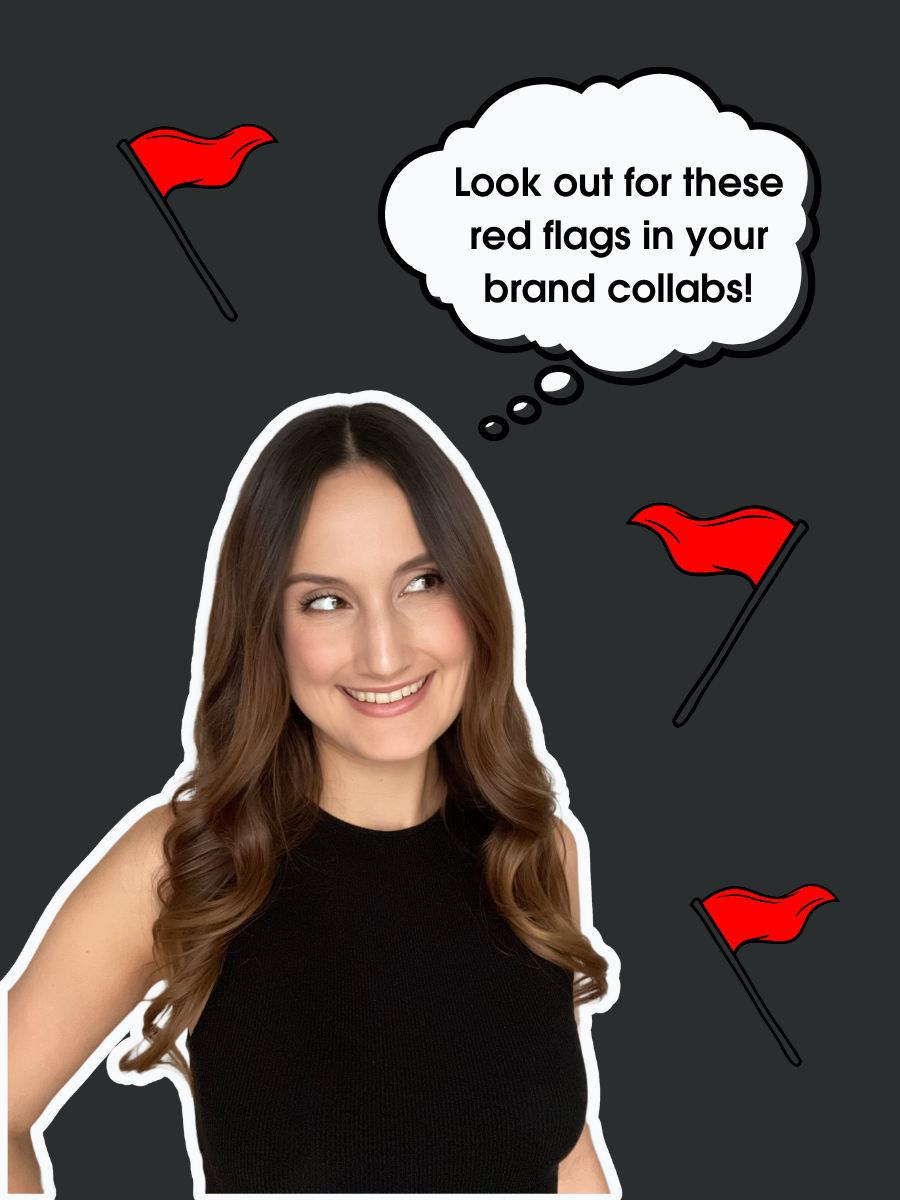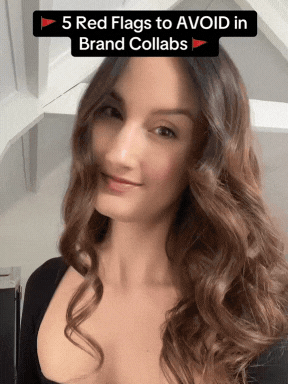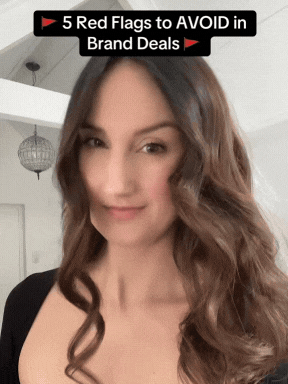25 Red Flags to Avoid When You Work with Brands (Part 4)
Are you going to work with brands on brand collabs? I'm sharing the major red flags you must avoid (and how) to protect yourself and get the most out of your deals!
It's very exciting to work with brands, but if you're anything like me, you want to make sure you actually get paid and protect your personal brand. As a lawyer myself who helps content creators and influencers like you, I'm spilling the tea on the common red flags in brand collabs and how you can protect yourself against them.
You will learn about the key red flags to avoid when you work with brands. I'll also share tips on how to work with brands on Instagram, TikTok, YouTube, and any other SM platform in a way that protects your interests!
After learning all about how to protect yourself against these major red flags, you'll know exactly how to work with brands and get paid while protecting your money and personal brand.
This post is all about the red flags to look out for when you work with brands so that you'll earn more and keep your money and personal brand safe.
Successful Work with Brands
Red flags to avoid & how to work with brands and get paid
The first 15 red flags
This blog post is Part 4 of the 5-part series on the common red flags to avoid when you work with brands.
If you haven't yet, make sure to read about the first 15 red flags in the first 3 parts of this series:
Now, let's get into the next 5 red flags to avoid!
Red Flag #16: (Shipping) costs are not covered
The Issue
One of the red flags that may arise when you work with brands is that costs are not covered. Here are some examples:
Paying for shipping & returns: The brand may ask you to pay for shipping costs or fail to specify whether shipping costs for both receiving and returning products are covered, and you end up with the bill.
No reimbursement for taxes: Maybe you have to pay hefty import taxes and duties for the products you receive from the brand, and the brand won't cover those.
No coverage for travel expenses: Maybe you need to travel to a specific location to create the content, but the brand does not reimburse you for those costs and those costs are not included in the price.
The Solution
Here are a few crucial terms you must include in your contract to safeguard against these red flags when you work with brands:
Clarify shipping (costs): Clearly state which costs are covered by the brand. If possible, itemise all the costs and expenses, including shipping costs, returns (if applicable), and travel expenses (if applicable).
Included in the price or not: State if certain or all costs and expenses are included in the fixed fee or not. If the exact amount of certain expenses is known, it's possible to add those to your fixed fee.
Specify reimbursement process: If (certain) expenses are not included in the fixed fee, specify the reimbursement process, for example, within 30 days of receiving proof of payment.
Now, it's clear who pays what and what you will actually earn on this deal, and you won't be surprised by hidden costs.
Red Flag #17: Product returns
The Issue
Another red flag when you work with brands is when they ask you to return their product. In most cases, the brand should not require you to return their product. You should promote a product's brand because you actually use and love the product, not just a one-off session.
In some cases, however, it does make sense, but then you might run into these red flags:
Unclear return terms: The contract does not specify whether you must return the product or how returns should be handled. Then, suddenly, the brand demands that you return the product after the content is created or posted.
No reimbursement for return shipping: The brand requires (and specifies in the contract that) you return the product, but the brand does not reimburse you.
The Solution
Keep or return: First, it must be clearly stated in the contract whether all or certain products must be returned or not. You might think that the brand doesn't want the used mascara back, but I've heard of crazier requests.
Specify return requirements: If the product must be returned, define when, for example, within 10 business days after all content has been posted or approved.
Clarify who covers return costs: Clarify who pays for those costs and if those costs are included in the fixed fee (refer to red flag #16).
Red Flag #18: Unclear compensation
The Issue
What might be the biggest red flag when you work with brands is unclear compensation. Here are some examples of where the compensation is unclear:
No fee: The contract does not specify the amount at all.
Unclear fee scope: The contract is so vague that you don't know if the compensation is for one post or a series of posts.
No fee breakdown: The contract may lump the total payment, but it does not break down what that amount is made up of (fee per post, exclusivity fee, usage rights fee for a specific period, whitelisting fee, etc.)
The Solution
Use a crystal-clear compensation clause that states the following:
Define compensation clearly: Specify the total compensation amount and include a breakdown of that amount into each fee that is charged based on your scope. Then, it's clear what the brand pays for and that any other work is notincluded in the fee.
Nothing out-of-scope: Explicitly state that any work that is not included in the scope will be charged an additional fee. I'll get deeper into fees for additional work in red flag #20.
Clear payment structure & schedule: Clearly define the payment structure and schedule for your fixed fee and other (recurring) fees. I'll get deeper into that payment structure and how to get paid in Part 5 of this series.
Red Flag #19: Conditional compensation
The Issue
Unfortunately, some brands will still include this term in your contract, so watch out for this one when you work with brands: conditional compensation.
Conditional compensation means that your pay is contingent on specific conditions, such as performance metrics (e.g., views, sales, engagement). MAJOR red flag!
You have put your time and energy into creating content for a brand, and you should always get paid for your work, regardless of how that content performs. You will never have control over that, so don't take responsibility for it and forgo your right to payment!
The Solution
Here's what you should do:
Reject the offer: Obviously, you should NEVER agree to conditional or performance-based compensation. If a brand approaches you with this, simply respond by stating that you will only accept work in which you are fairly compensated for your work and time and include your rate card. Don't have one? Make sure you get my FREE rate card template in this blog post!
Success fee: Maybe you want to work with a brand, but they don't have the budget to pay you your usual base rate. In that case, you may agree to a lower or discounted fee and, in addition, a success fee. A success fee is a fee that the brand must pay you if a certain metric is reached with your content, like x number of views, clicks, or conversions. Make sure you clearly specify that metric and the payment term.
Commission: Another fee that I recommend (regardless of whether you're collaborating at your usual fee or a discounted fee) is a commission. A commission is a payment of a certain percentage of the gross revenue received by the brand based on the number of sales or conversions made through your content. It's a great way to boost your income without having to do any additional work.
Red Flag #20: No fees for additional work
The Issue
Another red flag when you work with brands is when the contract does not include any provisions in relation to payment for additional work, which will cause several issues and uncertainties when the brand asks for additional work:
What will you charge for that additional work?
Perhaps you gave the brand a discounted fee for the project, but when the brand asks for additional content, will you be entitled to charge your usual fee, or will the brand expect the same discounted fee? Do you have to start negotiating again?
Since nothing is included in the contract for any additional work, you'll have to create a new contract for every single additional deliverable, resulting in a lot of wasted time!
The Solution
There are a few crucial provisions you must include in your contract:
Define the scope of work clearly: Make sure that the scope is as specific as possible so that it is clear what is and what is not within scope. I've gone deeper into this in red flag #3 in Part 1 of this series.
Additional charge for additional work: First, you must clarify in the contract that anything that is not specified within the scope is out of scope and that any service or deliverable outside of the scope will be charged at an additional fee.
Rate card: You must specify your fees for each type of service/deliverable so the brand can't renegotiate prices with you. So, you should attach your rate card to your contract and refer to those rates. Don't have one? Make sure you get my FREE rate card template in this blog post! Pro tip: Make sure you also state that your rates are subject to change (so they won't expect the same price a year later).
The next 5 red flags
In this blog post (Part 4 of the 5-part series), I only discussed 5 of the 25 red flags in brand collaborations.
If you haven't yet, make sure to read about the first 15 red flags discussed in the first 3 parts of this series:
Now, let's move on to Part 5, in which I'll discuss the next 5 red flags:
Unclear payment schedule
No (partial) upfront payment/deposit
No termination rights for you
Consequences upon termination
Penalties
The ultimate contract templates to work with brands for influencers
All the key protections you need to avoid major red flags can be included in an iron-clad, creator-friendly contract. You just need the right one...
The contract templates that I've created for every type of collab with brands are created to protect you against all these red flags. I've specifically designed them to help protect all kinds of creators with the legal armour they need and get the most out of their brand collabs.
So, if you want to avoid all the red flags and earn more, make sure to use these contract templates:
Brand Sponsorship Agreement, which also includes a step-by-step process so you know exactly how to work with brands and get paid.
Sponsored Post Agreement for if you're a blogger working with brands that collaborate with bloggers
Podcast Sponsorship Agreement for when you're collaborating with brands to create ads on your podcast
Content Creator Agreement for your UGC collabs
How to collaborate with brands on YouTube
Do you work with brands to create content for your YouTube Channel?
I've created an entire blog post on how to collaborate with brands on YouTube!
Make sure you read my blog post on the 9 KMust-Haves for Your YouTube Sponsorship Contract Template to Earn More & Keep Your Money.
This post was all about the red flags to look out for when you work with brands and how to create the best deals to earn more!
Get all the contract templates you need to work with brands (while protecting your business and bottom line):







